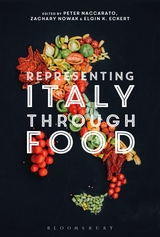Professor Maryann Tebben Writes About Italian/American Sauces
Dr. Maryann Tebben returns to gastronomic pursuits in her most recent publication “Semiotics of Sauce: National Identity and Naming of Pasta Sauces” in Representing Italy Through Food (Bloomsbury Academic, 2017).
 The new book examines the role of Italian food and foodways in romanticizing Italy,
from how perceptions are constructed and sustained to how they are represented in
the media. Editors Peter Naccarato, Zachary Nowak, and Elgin K. Eckbert bring together
established and emerging scholars to provide “both global and local perspectives –
which examine Italian food in the United States, Australia, and Israel – the book
reveals the power of representations across historical, geographic, socio-economic,
and cultural boundaries and asks if there is anything that makes Italy unique.”
The new book examines the role of Italian food and foodways in romanticizing Italy,
from how perceptions are constructed and sustained to how they are represented in
the media. Editors Peter Naccarato, Zachary Nowak, and Elgin K. Eckbert bring together
established and emerging scholars to provide “both global and local perspectives –
which examine Italian food in the United States, Australia, and Israel – the book
reveals the power of representations across historical, geographic, socio-economic,
and cultural boundaries and asks if there is anything that makes Italy unique.”
Maryann’s chapter explores Italian/American sauces and the myths about Italian cuisine. “Perhaps the most pervasive myth of Italian cuisine is the identification of spaghetti and tomato sauce as the national dish. It was not a regular feature on Italian tables until the nineteenth century and it is hardly representative of the vast Italian culinary landscape,” says Maryann. “In fact, Italians have an astounding number of sauces for pasta but these sauces remain stubbornly regional, such as ragù from Bologna, carbonara from Lazio/Abruzzo, Ligurian pesto, and Roman puttanesca.”
In contrast, when Italian immigrants recreated their food in America, they presented a unified and entirely constructed menu of ‘Italian’ specialties, repackaged as comprehensible foods under a unified ‘Italian’ identity, including tomato sauce on spaghetti.Ultimately, Maryann finds, tomato sauce for pasta is more American than Italian.
Maryann pays particular attention to the naming of sauce in and outside of Italy: “In spite of globalization elsewhere, sauce in Italy retains its regional character because the Italian language resists a unilateral designation for ‘sauce’ or even ‘pasta,’ while American English and the American-Italian tradition embrace ‘spaghetti sauce’ and ‘tomato gravy’.”
Reviews
“This intriguing interdisciplinary collection explores representations of Italian foodways in advertising, film, literature, cookbooks, and social media to address questions surrounding national identity, gender roles, change, and authenticity. Its detailed and fascinating case studies enrich understanding of Italian identity and food habits as they play out at home and are reimagined around the globe.” —Carole Counihan, Millersville University, USA
“This volume is a valuable addition to the field of Italian food studies. Its great virtue is giving equal importance to the use of food to represent the country to its own inhabitants, and the centrality of food in representations of Italy abroad.” —Jonathan Morris, University of Hertfordshire, UK
“Representing Italy Through Food is a unique multidisciplinary collection that looks at the ways in which Italian identity is constructed and promoted through food in Italy and abroad. The editors have brought together a collection of essays by Italian and international authors that range from literary representation of Italian food to the use of technology in promoting the Slow Food Movement. This volume is sure to be a useful resource for the Food Studies and Italian Studies classroom.” —Rachel Black, Connecticut College, USA